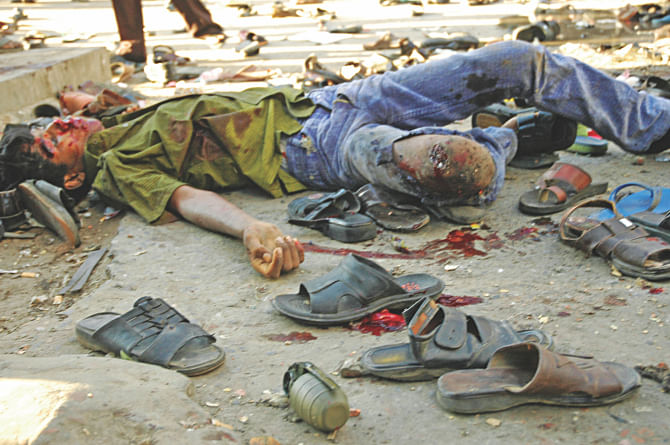Minutes after massacre
Minutes after massacre
Mind still numb, heart bleeds at the way state-sponsored terror struck

Walking through the busy, rain-soaked Bangabandhu Avenue yesterday, it was almost impossible to picture what had happened here 10 years ago.
Behind this scene of the hawkers selling sugarcane juice, the shuttered up shops and those ochre painted buildings lies a terrible moment of tragedy when scores of grenades were showered on Awami League President Sheikh Hasina and the entire top leadership of her party.
As I reached the spot minutes after the grenade attack on August 21, 2004, this busy avenue had turned into a mangled disaster scene. The truck on which Hasina was standing when the grenades were thrown lay there, its wooden sides splintered away.
Personal possessions lay trampled on the road -- purses and vanity bags, umbrellas and sandals. Broken wooden boards, heaps of rubbish and pieces of burned torn clothes. I could see limbs -- an entire fist with three fingers intact wedged under a wooden chair. Half a leg with tendons and ligaments mangled like some soggy fish lines.
And then the bodies -- dead and alive. By now almost all of them had been rushed along to the hospitals. The last few were being packed inside two white microbuses. Sirens screamed.
I saw the grenades, still intact and lying in the rubble. In their haste, the killers had forgotten to pull off the pins. The bottle-green metal, grooved like Kit-Kat chocolate, gleamed at me.
There was an eerie late afternoon silence in the air. People were standing at a distance without speaking or listening.
Then there was the Dhaka Medical College Hospital. Wards 29, 30, 31, 32.
It was a strange scene one wished one had never witnessed. People were lying everywhere. Bleeding and limbless. A terrible thing had happened to them, by some dark magic their skins had vanished. A whitish coat covered their bodies. It was not even pink.
The doctors and the nurses were running around. Every minute was valuable to them and they just worked like some machines. Bandaging, applying medicines, stitching up.
I saw this man sitting silently on a bed, his whole body turned white. He did not cry, he did not scream, he just looked blankly in front.
I listened to the human voice here. It had a syncopation, a terrible prosody. I could hear approaching death in their high and shrill cries that dipped into deep groans.
On a corridor I saw Awami League's then general secretary Abdul Jalil sitting on the floor. His back to the wall. A deep blank look in his eyes. Terror and tragedy written all over his face. His white punjabi was blood smeared.
Just beside him lay the body of a woman, dead. Her legs were touching Jalil. But he simply was not noticing that. Blankness was all.
More bodies started coming. More cries. More blank looks.
That was what August 21 looked like.
And then one must question what role the BNP-led government had played in this terrible massacre. Two of its top leaders -- Tarique Rahman, son of Khaleda Zia, who was then prime minister, and Lutfozzaman Babar, who was her state minister for home, are implicated. It is now clear how the state machinery, including some officials of the DGFI and NSI, were used in this orchestration.
And one must ask about the role that Khaleda herself played. The cruelty with which she showed indifference to this heinous crime is unpardonable.
Remembering that fateful day of 2004, one can also wonder what minds had created this tragedy and whether they repent it.